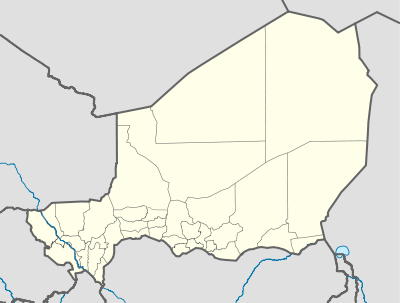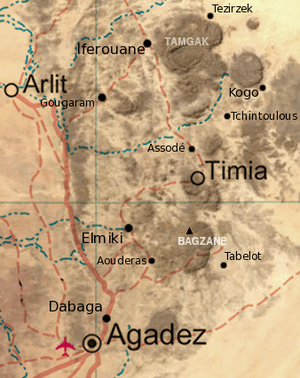Iferouane
Iferouane (French: Iférouane), also spelled Iferouan, is an oasis town and commune in northern Niger, in Agadez Department. It is located northeast of Arlit in the northern Aïr,[2] in the Ighazar valley[3] near the Tamgak Range.[4]
Iférouane Iferouan, | |
|---|---|
 Iférouane Location in Niger | |
| Coordinates: 19°04′N 8°24′E | |
| Country | |
| Region | Agadez Region |
| Department | Arlit Department |
| Elevation | 660 m (auto ft) |
| Population (2012[1]) | |
| • Urban | 2,486 |
| • Summer (DST) | UTC+1 (WAT) |

Iferouane is also the location of the headquarters of the Aïr and Ténéré Natural Reserves, a World Heritage Site covering more than 7,700,000 ha (19,000,000 acres).[5] The Project for the Conservation and Management of the Natural Resources of the Aïr-Ténéré, a joint venture between the government of Niger, the World Conservation Union (IUCN), and the World Wide Fund for Nature (WWF), is also based in Iferouane.[6]
The town has one airport: Iferouane Airport (ICAO: DRZI).
History
The Foureau-Lamy Mission, a French military expedition led by Fernand Foreau and Amédée-François Lamy, spent a number of months at Iferouane in 1899. The expedition stopped at Iferouane on 24 February 1899 to acquire additional pack animals, their number having dwindled from 1,004 to 585, and departed on 10 June 1899, heading for Agadez. During this time, the expeditionary force faced multiple attacks by Tuareg nomads and saw the size of its caravan dwindle from 585 camels to 75.[7][8]
During Niger's colonial period, Iferouane was the northernmost military outpost in the French colony.[4] In 1964, a few years after independence, the population of Iferouane cercle was approximately 10,000.[9]
Second Tuareg Rebellion
Iferouane was the site of the first attack carried out by the Niger Movement for Justice (MNJ),[10] which marked the beginning of the Second Tuareg Rebellion. Numerous clashes between rebel and government forces subsequently took place near the town, including an attack in early December 2007 against a supply convoy heading for Iferouane that resulted in the deaths of three soldiers and, according to the government, eight rebels.[11][12]
In October 2007, the president of the SOS Iférouane Initiative, a local organisation involved with delivering supplies to the town, reported that – due to the insecurity caused by the rebellion – the residents of Iferouane had been without food for a number of weeks. He also reported an increase in the incidence of malaria and diarrhoea among the town's residents.[13]
In November, Iferouane's deputy mayor reported that the town's entire population – approximately 5,000 residents – had left due to shortages of food, the Tuareg rebellion, and "harassment" by the army. The central government, based in Niamey, confirmed that supplies to the town were blocked due to the mining of roads by rebels, but denied that the town had been emptied.[14]
In November 2008, a Radio France International reporter visited the town and described it as "empty of inhabitants", with the entire population having fled to Arlit or Agadez.[15] During 2009, the inhabitants started to return and by September, about 90% of the population had returned and agriculture had restarted, despite damaged infrastructure.[16]
Climate
Iferouane receives, on average, in excess of 50 mm of rainfall per year, which falls in the course of a few heavy downpours during the summer months.[6] Mean rainfall per annum was 58.2 mm (2.29 in) from 1940 to 1989, and 76.1 mm (3.00 in) between 1990 and 2004.[17] Temperatures as low as −1 °C (30 °F) and as high as 52 °C (126 °F) have been recorded.[5]
See also
References
- http://citypopulation.de/Niger-Cities.html
- Casserly, Gordon (1923). Algeria To-day. F.A. Stokes. p. 215. Retrieved 10 December 2007.
- Rodd, Francis (January 1929). "A Second Journey among the Southern Tuareg". The Geographical Journal. 73 (1): 81–101. doi:10.2307/1781334. JSTOR 1781334.
- Cameron, D.R.G. (June 1928). "A Journey across the Sahara from Kano to Ouarghla". The Geographical Journal. 71 (6): 538–59. doi:10.2307/1783174. JSTOR 1783174.
- "Air and Ténéré Natural Reserves". Protected Areas Programme. World Conservation Monitoring Centre, United Nations Environment Programme. April 2002. Archived from the original on 29 September 2007. Retrieved 10 December 2007.
- Gordon, Claire (June 1993). "Unstabilised Earth-Brick Vaults and Domes in the Sahel". Development in Practice. 3 (2): 127–32. doi:10.1080/096145249100077151. JSTOR 4028958.
- Fleming, Fergus (2004). The Sword and the Cross: Two Men and an Empire of Sand. Grove Press. p. 102. ISBN 978-0-8021-4173-6. Retrieved 12 October 2007.
- Fleming, Fergus (2006). Off the Map: Tales of Endurance and Exploration. Grove Press. p. 401. ISBN 978-0-8021-4272-6. Retrieved 12 October 2007.
- Mortimore, Michael J. (January 1972). "The Changing Resources of Sedentary Communities in Air, Southern Sahara". Geographical Review. 62 (1): 71–91. doi:10.2307/214060. JSTOR 214060.
- De Capua, Joe (28 November 2007). "Tuareg rebels gathering strength in Niger". Voice of America. Retrieved 10 December 2007.
- Schwarz, Naomi (5 December 2007). "Niger Rebels Attack Convoy, Refuse to Negotiate". VOA News. Archived from the original on 13 December 2007. Retrieved 10 December 2007.
- Massalatchi, Abdoulaye (5 December 2007). "Niger rebels kill 3 soldiers in attack on convoy". Reuters. Archived from the original on 1 February 2013. Retrieved 10 December 2007.
- "NIGER: Humanitarian crisis feared in north". IRIN. 22 October 2007. Retrieved 10 December 2007.
- "Niger raids leaves 'ghost town'". BBC. 19 November 2007. Retrieved 10 December 2007.
- "Niger : Iferouane vidé de ses habitants". Raliou Assaleh Hamed, RFI. 13 November 2008. Retrieved 6 February 2009.
- "Niger: Lull in conflict favours return in the north". International Displacement Monitoring Centre. 8 September 2009. Archived from the original on 30 January 2010. Retrieved 24 January 2010..
- Anthelme, F., R. Michalet, and M. Saadou (February 2007). "Positive associations involving the tussock grass Panicum turgidum Forssk. in the Aïr-Ténéré Reserve, Niger". Journal of Arid Environments. 68 (3): 348–62. doi:10.1016/j.jaridenv.2006.07.007.CS1 maint: multiple names: authors list (link)